The Memblaze PBlaze6 6530 series is the company’s newest addition to the company’s PCIe Gen4 enterprise SSD portfolio. Designed for the mainstream enterprise market, the new PBlaze6 6530 series is based on the company’s self-developed Unified Framework Platform (MUFP) and 176-layer enterprise 3D eTLC NAND flash. Memblaze highlights its significant improvement in power efficiency (172% better than the PBlaze6 6920), which allows for significant cost savings for organizations with larger deployments. The new Memblaze PBlaze6 6530 Series includes two models: the PBlaze6 6530 and the PBlaze6 6536, the latter of which we will be looking at for this review.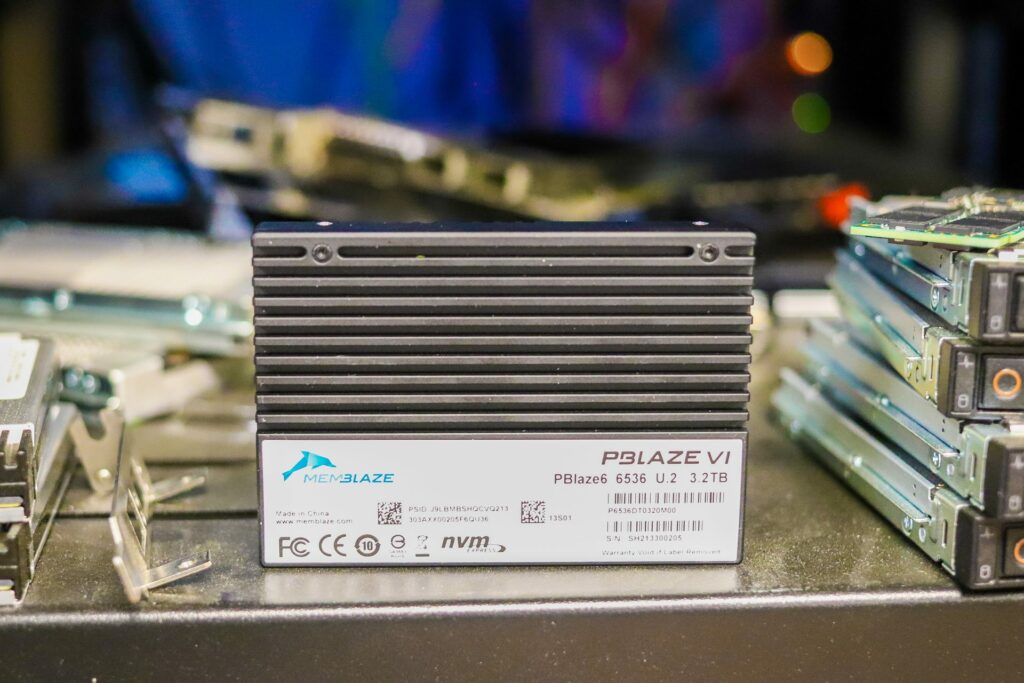
Memblaze PBlaze6 6530 vs. 6536
As far as performance goes, the PBlaze6 6536 offers a slightly different profile. In sequential reads and write, it is quoted to deliver up to 6.8GB/s and 4.8GB/s, respectively, while sustained random reads are quoted at 1.1 million IOPS. While the 6530 is specced with these same numbers, sustained random write performance differs significantly. Here, the highest capacity model of PBlaze6 6536 offers 425,000 IOPS compared to the 230,000 IOPS of the PBlaze6 6530.
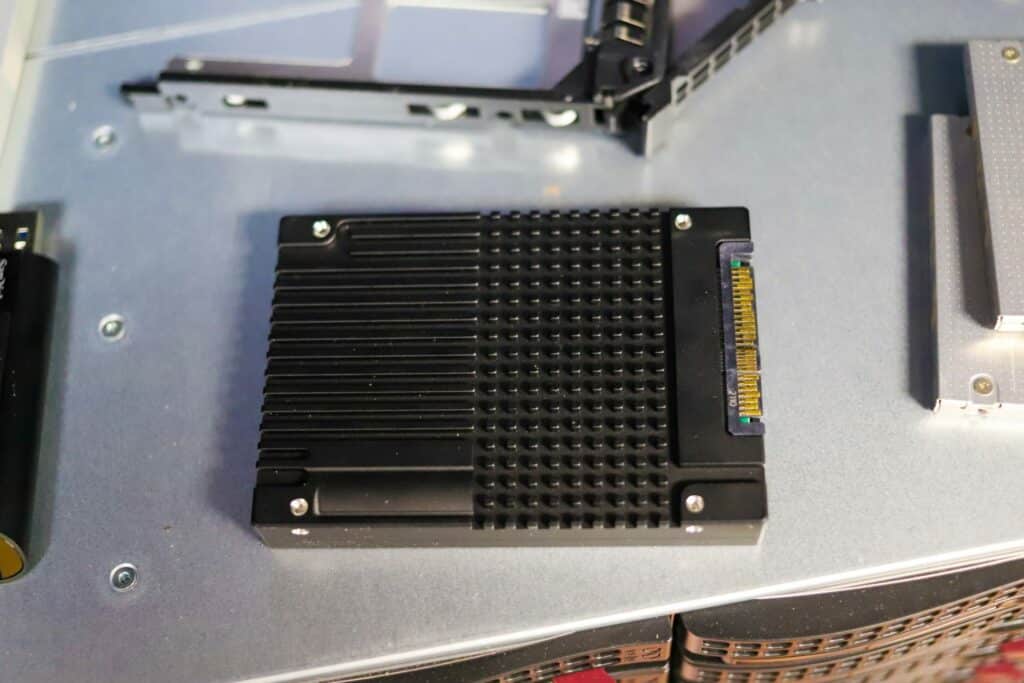
Another difference is the lifetime endurance, as the PBlaze6 6536 features a DWPD (Drive Writes per Day for 5 years) rating of 3.3 while the 6530 is quoted at 1.5. This makes the 6536 more suitable for businesses with higher write endurance needs.
Enterprise-Grade Features
The PBlaze6 6530 series is equipped with a wide range of features useful for the enterprise. This includes supporting up to 32 namespaces, sharing capacity and performance on a single drive, and allowing users to upgrade drive firmware without having to stop businesses operations or shut down any systems. This is especially important for critical business use cases and those who want to lessen the complexity of wide-scale SSD upgrades.
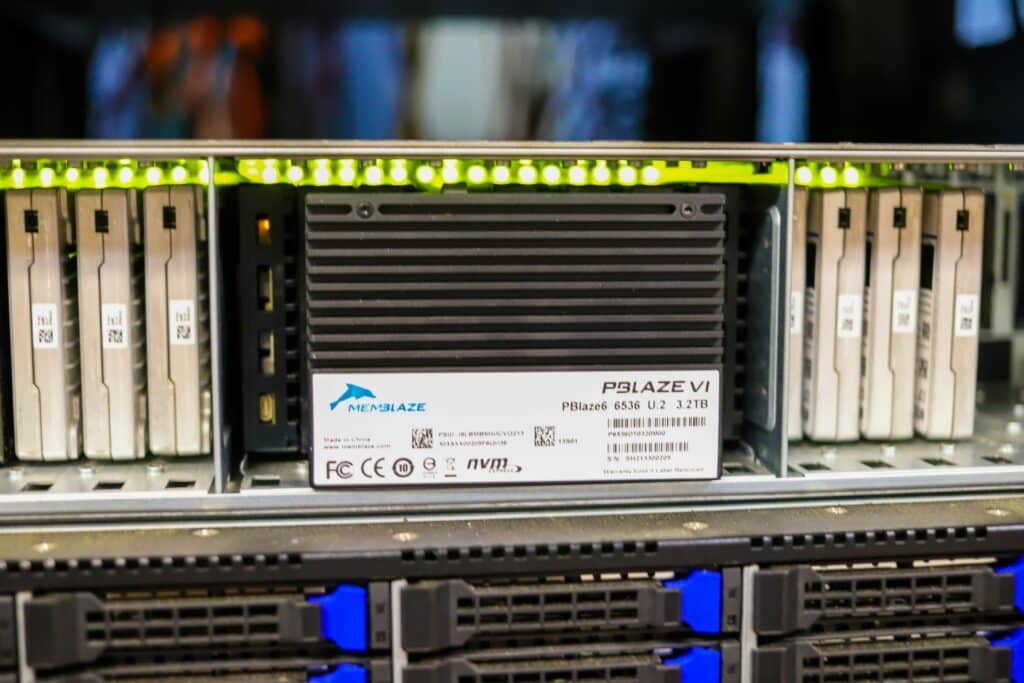
The PBlaze6 6530 series also offers S.M.A.R.T and capacitor health check features, allowing for detailed drive diagnostic testing. Moreover, the new Memblaze drive supports NVMe-MI interface for inventory, monitoring health status, configuration, and change management.
The PBlaze6 6530 Series is available in capacities of 1.92TB, 3.84TB and 7.68TB while the PBlaze6 6536 Series offers 1.6TB, 3.2TB, and 6.4TB capacity, all of which come in 2.5-inch U.2 and HHHL AIC form factor options. Memblaze indicates that this drive is designed for hyperscale users in internet, cloud computing, finance, and telecommunications environments.
Our review unit is the 3.2TB 6536.
Memblaze PBlaze6 6530 Family Specifications
| PBlaze6 6530 Series | C/D6530 | C/D6536 | ||||
| User Capacity | 1.92TB | 3.84TB | 7.68TB | 1.6TB | 3.2 TB | 6.4TB |
| 128KB Sequential Read (GB/s) | 6.8 | 6.8 | 6.5 | 6.8 | 6.8 | 6.5 |
| 128KB Sequential Write (GB/s) | 2.7 | 4.8 | 4.9 | 2.7 | 4.9 | 4.8 |
| Sustained Random Read (4KB) IOPS | 910K | 1100K | 1100K | 910K | 1100K | 1100K |
| Sustained Random Write (4KB) IOPS
(Steady State) |
110K | 193K | 230K | 230K | 415K | 425K |
| Lifetime Endurance | 1.5 | 1.5 | 1.4 | 3.3 | 3.3 | 3.2 |
| Latency Read/Write (μs) | 72 / 10 | |||||
| Interface | PCIe 4.0 x 4 | |||||
| Form Factor | HHHL AIC / 2.5-inch U.2 | |||||
| Operating Temperature | 2.5-inch U.2: Ambient: 0°C to 35°C with suggested airflow; Case: 0°C to 70°C AIC: Ambient 0°C to 55°C with suggested airflow | |||||
| Uncorrectable Bit Error Rate | -17
< 10 |
|||||
| Mean Time Between Failures | 2 million hours | |||||
| Protocol | NVMe 1.4 | |||||
| NAND Flash Memory | New Generation 3D NAND | |||||
| Operation System | RHEL, SLES, CentOS, Ubuntu, Windows Server, VMware ESXi | |||||
| Power Consumption | Up to 14 Watt | |||||
| Basic Feature Support | Power Failure Protection, Hot Pluggable,
Full Data Path Protection, S.M.A.R.T, Flexible Power Management |
|||||
| Advanced Feature Support | TRIM, Multi-namespace, AES 256 Data Encryption & Crypto Erase, EUI64/NGUID Variable Sector Size Management & NVMe End-to-End Data Protection (DIF/DIX), Firmware Upgrade without Reset, Latency Statistics & High Latency Logging, Timestamp, Weighted Round Robin (WRR), Telemetry, Sanitize,
Persistent Event Log, TCG OPAL2.0 |
|||||
| Software Support | Open-source management tool, CLI debug tool OS in-box driver (Easy system integration) | |||||
Memblaze PBlaze6 6536 Performance
Testing Background and Comparables
The StorageReview Enterprise Test Lab provides a flexible architecture for conducting benchmarks of enterprise storage devices in an environment comparable to what administrators encounter in real deployments. The Enterprise Test Lab incorporates a variety of servers, networking, power conditioning, and other network infrastructure that allows our staff to establish real-world conditions to accurately gauge performance during our reviews.
We incorporate these details about the lab environment and protocols into reviews so that IT professionals and those responsible for storage acquisition can understand the conditions under which we have achieved the following results. None of our reviews are paid for or overseen by the manufacturer of equipment we are testing. Additional details about the StorageReview Enterprise Test Lab and an overview of its networking capabilities are available on those respective pages.
Comparables:
Testbed
Our PCIe Gen4 Enterprise SSD reviews leverage a Lenovo ThinkSystem SR635 for application tests and synthetic benchmarks. The ThinkSystem SR635 is a well-equipped single-CPU AMD platform, offering CPU power well in excess of what’s needed to stress high-performance local storage. It is also the only platform in our lab (and one of the few on the market currently) with PCIe Gen4 U.2 bays. Synthetic tests don’t require a lot of CPU resources but still leverage the same Lenovo platform. In both cases, the intent is to showcase local storage in the best light possible that aligns with storage vendor maximum drive specs.
PCIe Gen4 Synthetic and Application Platform (Lenovo ThinkSystem SR635)
- 1 x AMD 7742 (2.25GHz x 64 Cores)
- 8 x 64GB DDR4-3200MHz ECC DRAM (1 x 64GB for Houdini)
- CentOS 7.7 1908
- Ubuntu 20.10-desktop
- ESXi 6.7u3
SQL Server Performance
Each SQL Server VM is configured with two vDisks: 100GB volume for boot and a 500GB volume for the database and log files. From a system resource perspective, we configured each VM with 8 vCPUs, 64GB of DRAM and leveraged the LSI Logic SAS SCSI controller. While our Sysbench workloads tested previously saturated the platform in both storage I/O and capacity, the SQL test is looking for latency performance.
This test uses SQL Server 2014 running on Windows Server 2012 R2 guest VMs and is stressed by Quest’s Benchmark Factory for Databases. StorageReview’s Microsoft SQL Server OLTP testing protocol employs the current draft of the Transaction Processing Performance Council’s Benchmark C (TPC-C), an online transaction-processing benchmark that simulates the activities found in complex application environments. The TPC-C benchmark comes closer than synthetic performance benchmarks to gauging the performance strengths and bottlenecks of storage infrastructure in database environments. Each instance of our SQL Server VM for this review uses a 333GB (1,500 scale) SQL Server database and measures the transactional performance and latency under a load of 15,000 virtual users.
SQL Server Testing Configuration (per VM)
- Windows Server 2012 R2
- Storage Footprint: 600GB allocated, 500GB used
- SQL Server 2014
-
- Database Size: 1,500 scale
- Virtual Client Load: 15,000
- RAM Buffer: 48GB
- Test Length: 3 hours
-
- 2.5 hours preconditioning
- 30 minutes sample period
For our SQL Server transactional benchmark, the PBlaze6 6530 placed first among the tested drives with 12,650.4 TPS.
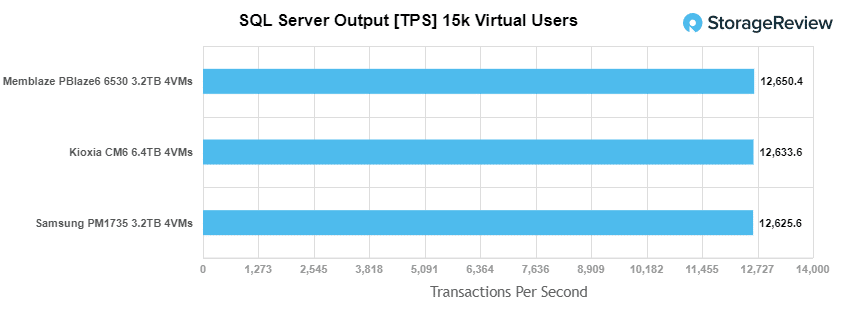
With SQL Server average latency, the PBlaze6 6530 posted an average latency of 2.3ms, noticeably better than the KIOXIA and Samsung drives.
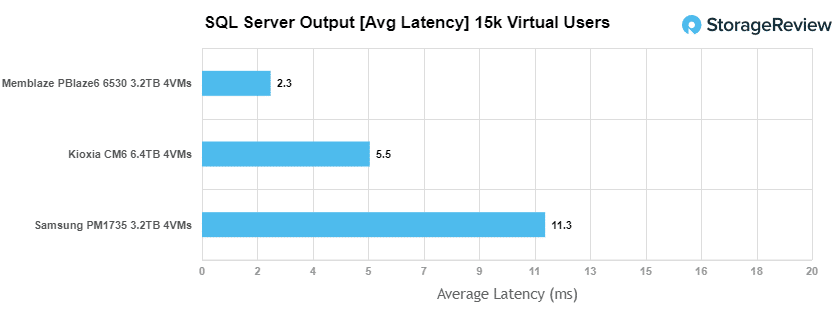
Sysbench Performance
The next application benchmark consists of a Percona MySQL OLTP database measured via SysBench. This test measures average TPS (Transactions Per Second), average latency, and average 99th percentile latency as well.
Each Sysbench VM is configured with three vDisks: one for boot (~92GB), one with the pre-built database (~447GB), and the third for the database under test (270GB). From a system resource perspective, we configured each VM with 8 vCPUs, 60GB of DRAM and leveraged the LSI Logic SAS SCSI controller.
Sysbench Testing Configuration (per VM)
- CentOS 6.3 64-bit
- Percona XtraDB 5.5.30-rel30.1
-
- Database Tables: 100
- Database Size: 10,000,000
- Database Threads: 32
- RAM Buffer: 24GB
- Test Length: 3 hours
-
- 2 hours preconditioning 32 threads
- 1 hour 32 threads
Looking at our Sysbench transactional benchmark, the Memblaze PBlaze6 6530 had 9,021 TPS for the top spot.
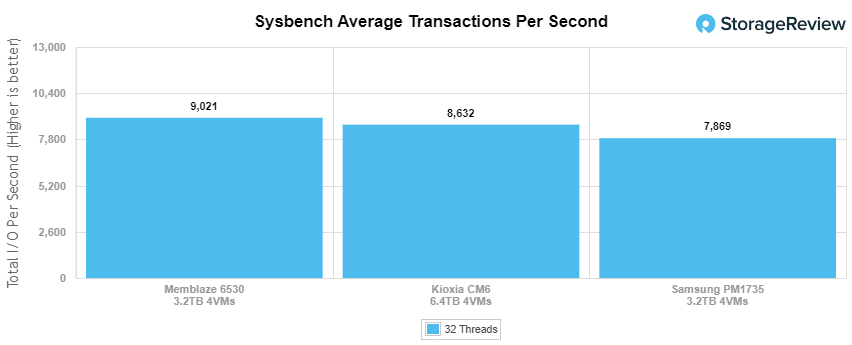
With Sysbench average latency, the PBlaze6 6530 posted 14.19ms, which was slightly better than the KIOXIA drive.
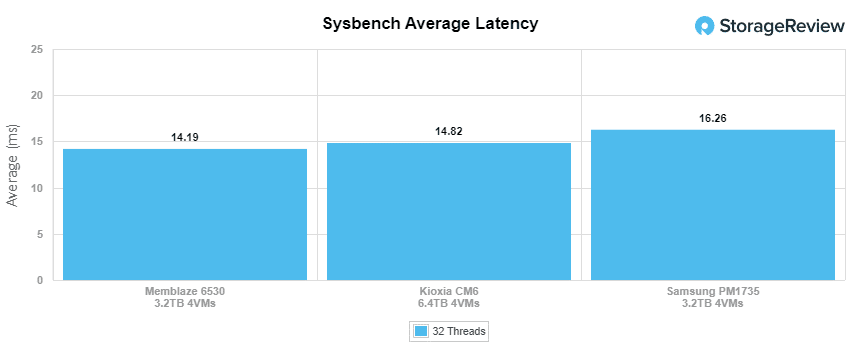
For our worst-case scenario latency (99th percentile) the PBlaze6 6530 place third with 26.06ms.
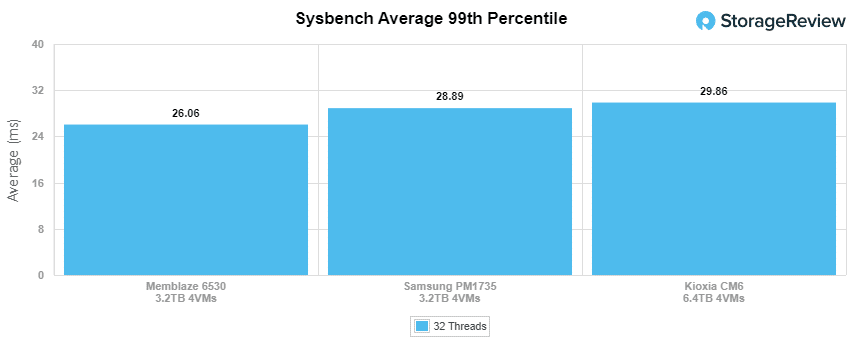
VDBench Workload Analysis
When it comes to benchmarking storage devices, application testing is best, and synthetic testing comes in second place. While not a perfect representation of actual workloads, synthetic tests do help to baseline storage devices with a repeatability factor that makes it easy to do apples-to-apples comparisons between competing solutions. These workloads offer a range of different testing profiles ranging from “four corners” tests, common database transfer size tests, to trace captures from different VDI environments.
All of these tests leverage the common vdBench workload generator, with a scripting engine to automate and capture results over a large compute testing cluster. This allows us to repeat the same workloads across a wide range of storage devices, including flash arrays and individual storage devices. Our testing process for these benchmarks fills the entire drive surface with data, then partitions a drive section equal to 25% of the drive capacity to simulate how the drive might respond to application workloads. This is different than full entropy tests which use 100% of the drive and takes them into a steady state. As a result, these figures will reflect higher-sustained write speeds.
Profiles:
- 4K Random Read: 100% Read, 128 threads, 0-120% iorate
- 4K Random Write: 100% Write, 128 threads, 0-120% iorate
- 64K Sequential Read: 100% Read, 32 threads, 0-120% iorate
- 64K Sequential Write: 100% Write, 16 threads, 0-120% iorate
- Synthetic Database: SQL and Oracle
- VDI Full Clone and Linked Clone Traces
In our first VDBench Workload Analysis, Random 4K Read, the PBlaze6 6530 had a peak performance of 1.18 million IOPS at a latency of 415.9µs.
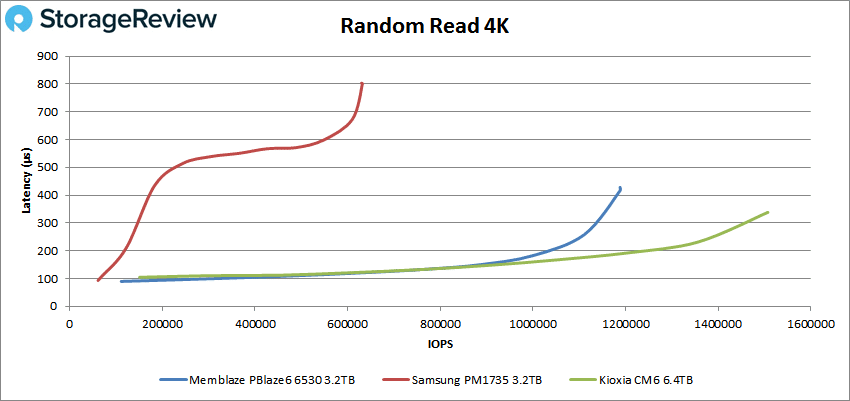
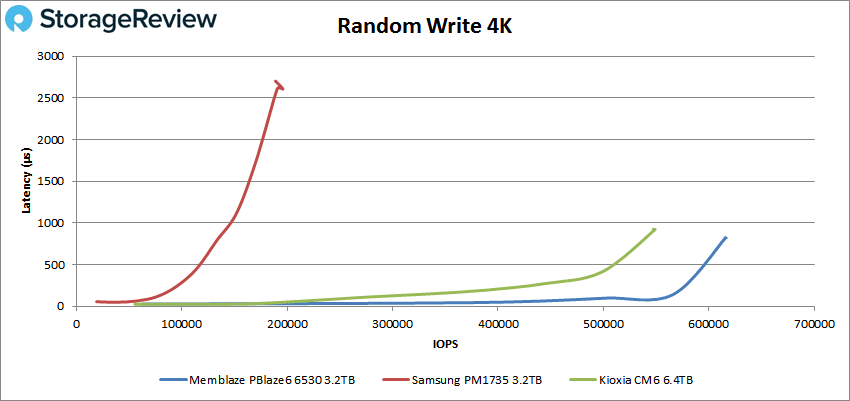
Switching over to 64k sequential workloads, the PBlaze6 6530 took the top spot, narrowly beating out the Kioxia drive at the very end of the test. Here, it posted 6.3GB/s read (100,879 IOPS) at 619 µs in latency
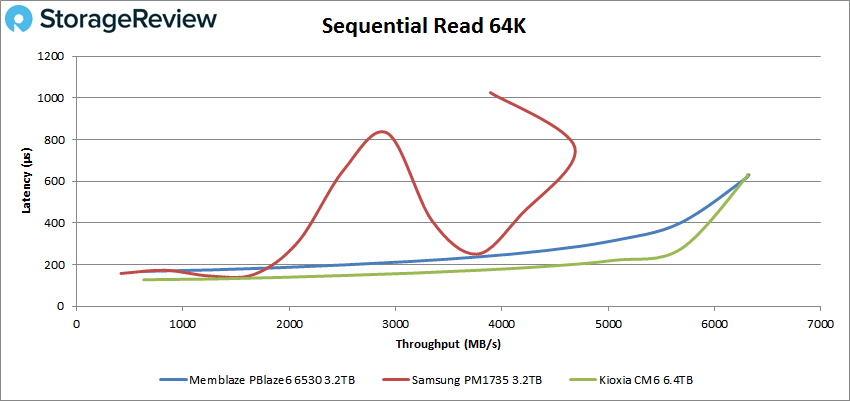
In 64K write, the PBlaze6 6530 performed well again, peaking at 3.66GB/s (58,543 IOPS) with a latency of 1,084µs. These results were much better than the Samsung and Kioxia drives.
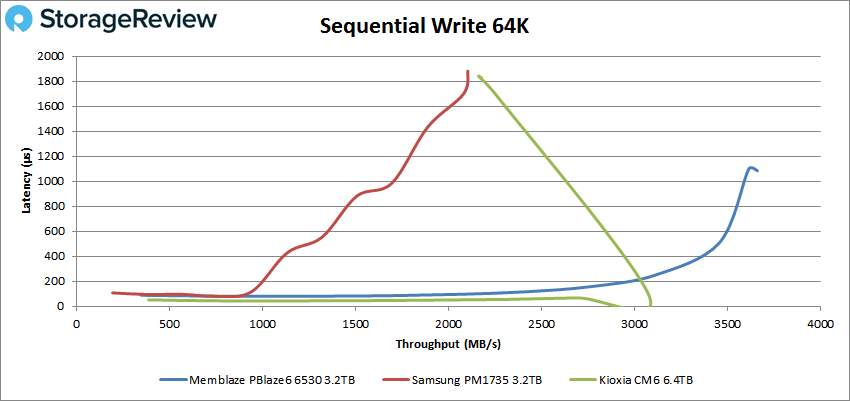
Our next set of tests is our SQL workloads: SQL, SQL 90-10, and SQL 80-20, all of which showed similar results. Starting with SQL, the new Memblaze drive had a peak performance of 254,824 IOPS at a latency of 124.5µs.
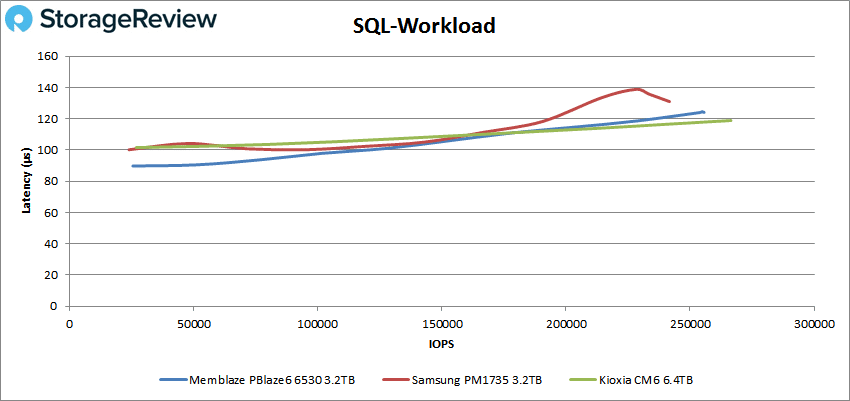
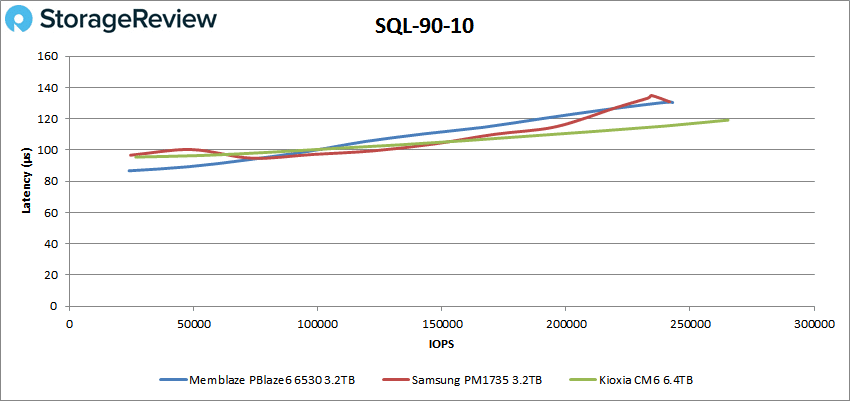
With SQL 80-20, the new PBlaze6 6530 fell back just a bit with a peak performance of 211,053 IOPS at a latency of 148.6µs.
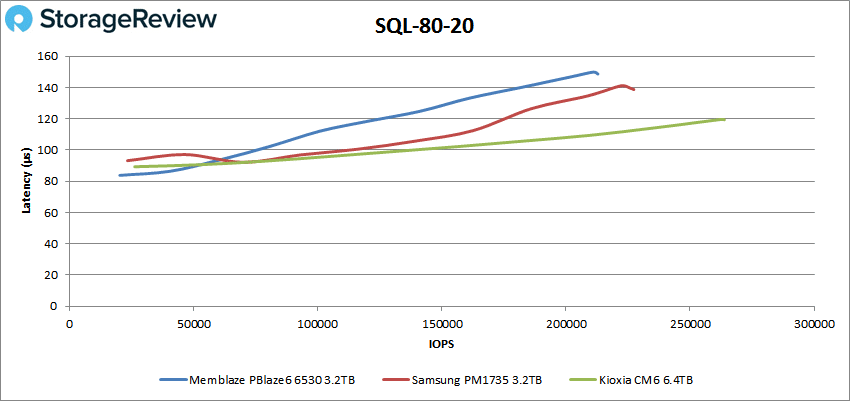
Next up are our Oracle workloads: Oracle, Oracle 90-10, and Oracle 80-20. Like with the SQL benchmarks, the PBlaze6 6530 continued its solid performance. Starting with Oracle, the PBlaze6 6530 had a peak performance of 221,897 IOPS at 156.6µs (just behind the Samsung drive).
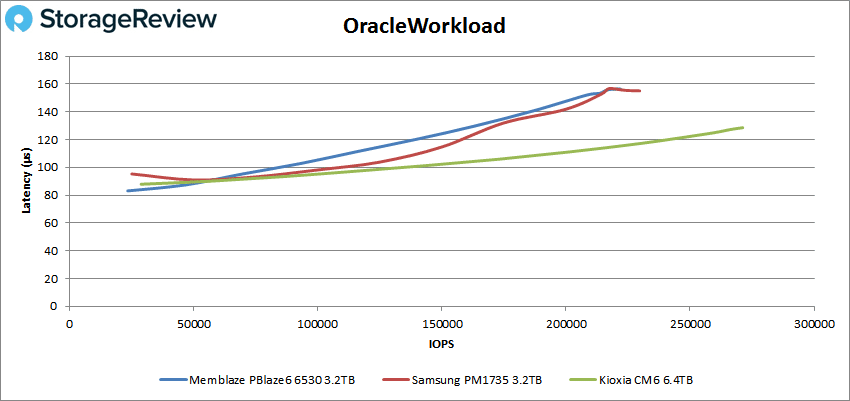
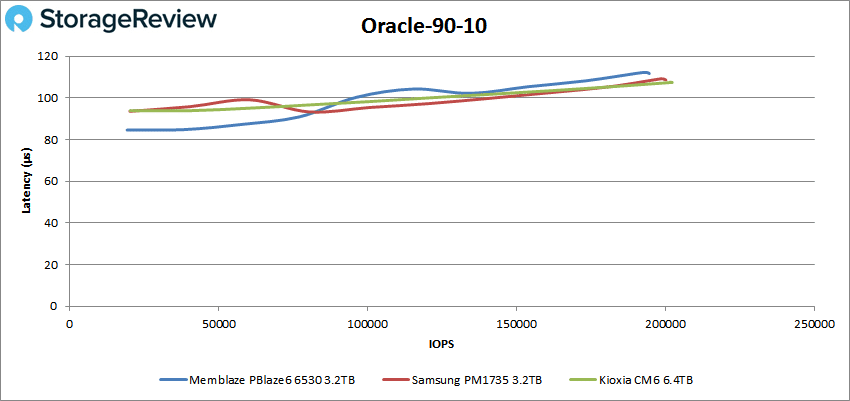
Looking at Oracle 80-20, the PBlaze6 6530 took posted a peak performance of 179,638 IOPS at 120.8µs, slightly trailing the Samsung PM1735 and Kioxia CM6.
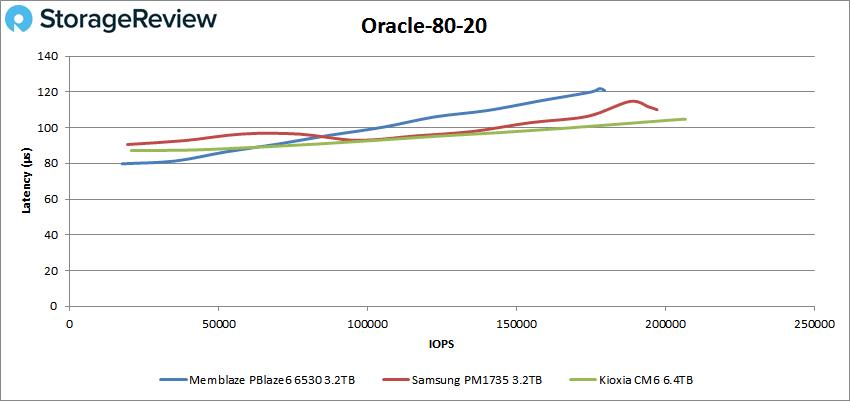
Next, we switched over to our VDI clone test, Full and Linked. For VDI Full Clone (FC) Boot, the PBlaze6 6530 placed second trailing the Kioxia drive with a peak of 201,454 IOPS at a latency of 170.1µs.
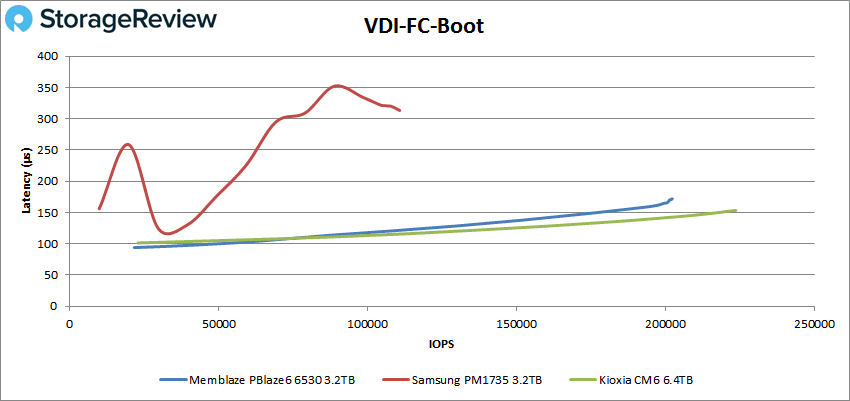
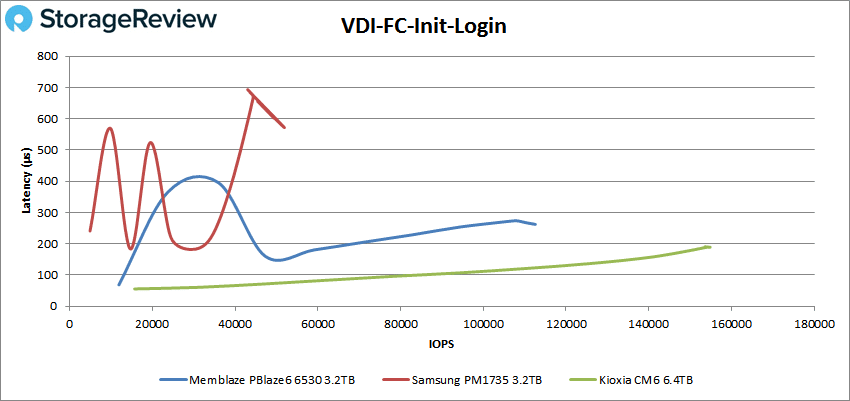
With VDI FC Monday Login, the PBlaze6 6530 placed a hair better than the Samsung drive with 68,445 IOPS with a latency of 230.4µs.
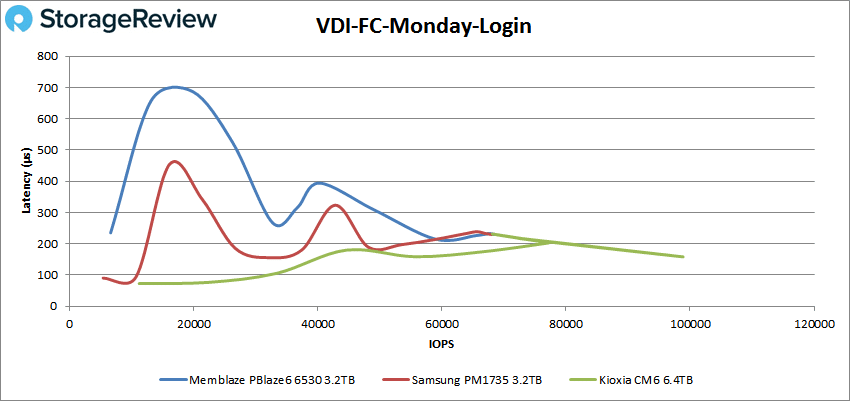
For VDI Linked Clone (LC) Boot, the PBlaze6 6530 had a peak of 100,065 IOPS and a latency of 159.1µs.
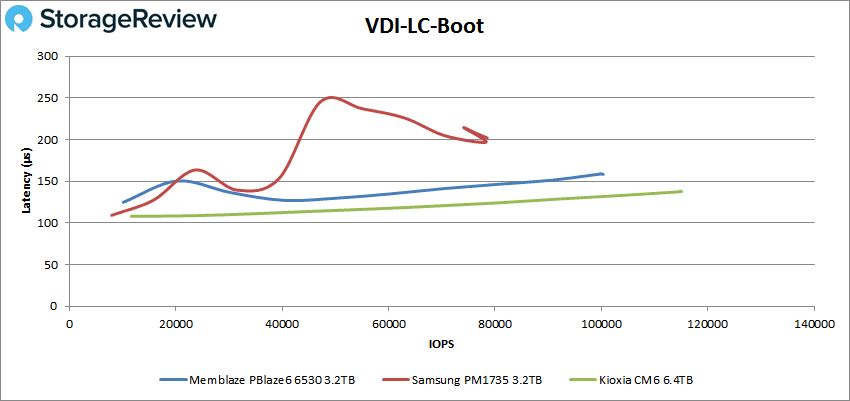
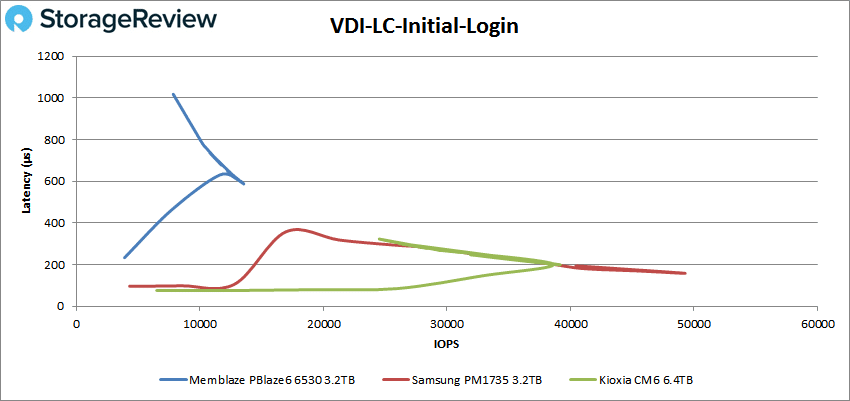
For VDI LC Monday Login, the PBlaze6 6530 showed 56,426 IOPS at 282.8 µs.
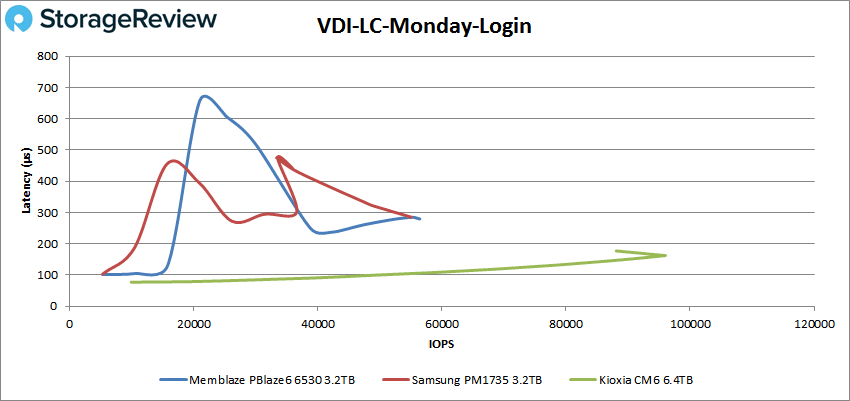
Conclusion
The Memblaze PBlaze6 6530 series is the company’s newest PCIe Gen4 enterprise SSD targeted more towards a mainstream market with two different endurance ratings. Touted as a successor to the PBlaze6 6920 SSD series released back in April of this year, the new Memblaze drive is highlighted by its improvement in power efficiency.
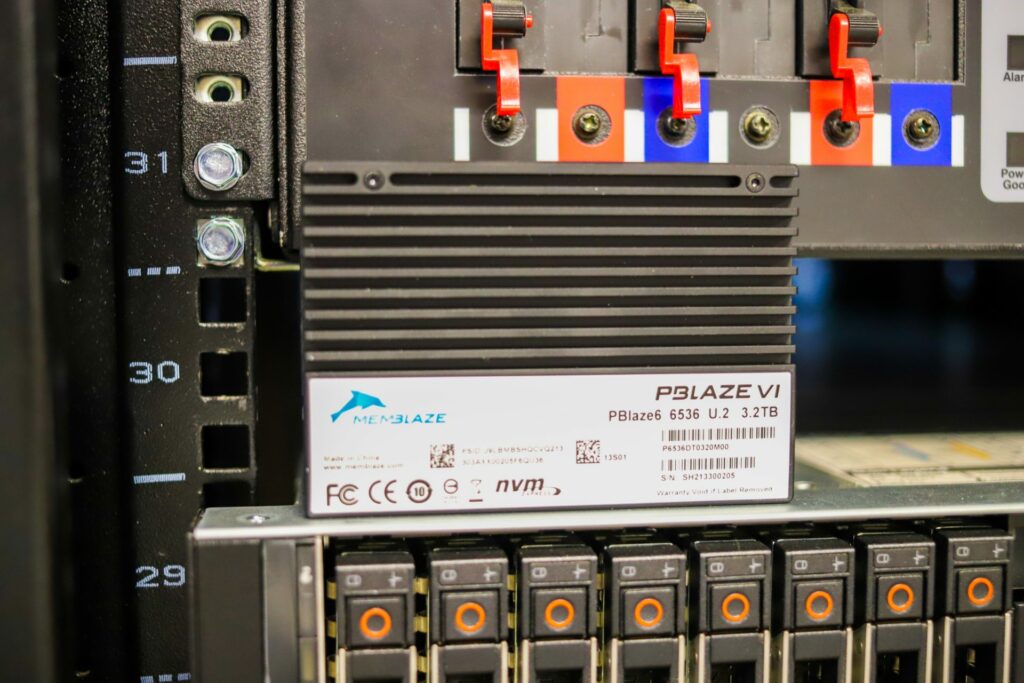
The new Memblaze 6530 Series is comprised of the PBlaze6 6530 and PBlaze6 6536 (the latter high-endurance model which we looked at for this review) and is available in capacities up to 7.68TB. Both are based on Memblaze’s self-developed Unified Framework Platform (MUFP) and are equipped with 176-layer enterprise 3D eTLC NAND flash. The PBlaze6 6536 is more suitable for harsher workloads due to its higher write endurance capabilities.
As for how our review model performed during lab benchmarks, the results were pretty solid overall. We tested the PBlaze6 6536 against two other PCIe Gen4 enterprise SSDs with a 3DWPD rating (Samsung PM1735 and the KIOXIA CM6) and looked at both application workload analysis and VDBench. In our Sysbench tests, we saw the 6536 performed very well with aggregate scores of 9,020.5 TPS, 14.19ms in average latency, and 26.06ms in a worst-case scenario; all of which took the top spot. This trend continued during our SQL Server transactional benchmark, where it posted 12,650.4 TPS and an average latency of just 2.3ms.
Switching over to our VDBench, the PBlaze6 6536 results were pretty much what we were expecting. Highlights include 1.18 million IOPS in 4K read and 616K IOPS in 4K write, while sequential workloads saw 6.3GB/s in 64K read and 3.66GB/s in 64K write.
In our SQL testing, the PBlaze6 6536 saw peaks of 255K IOPS, 242K IOPS in SQL 90-10, and 211K IOPS in SQL 80-20. Oracle workloads posted 222K IOPS, 194K IOPS in Oracle 90-10, and 180K IOPS in Oracle 80-20.
Next up were our VDI Clone tests, Full and Linked, where its performance was overall fairly even. In Full Clone, we saw 201K IOPS in boot, 113K IOPS in Initial Login, and 68K IOPS in Monday Login. In Linked Clone, the new PBlaze drive showed a peak of 100K IOPS in boot and 56K IOPS in Monday Login. Initial Login is the only test that Memblaze drive struggled with, as it essentially plummeted right out of the gate with unusable performance. It eventually hit 13,363 IOPS then took another big spike, ending the test at just 7,836 IOPS with 1,017.6µs.
Memblaze might not be the most recognizable brand in the US, but their SSDs have always been impressive performers in our lab. The new PBlaze6 6530 series is no exception here, Memblaze once again posts a very impressive showing. They simply keep producing great SSDs, a pattern that’s quite enjoyable for us to be a part of. Every time one of these drives shows up for review, we know we’re in for an easy ride.




 Amazon
Amazon